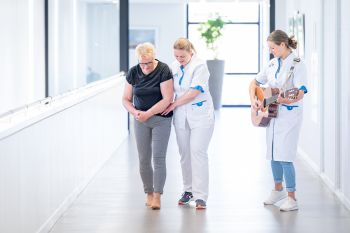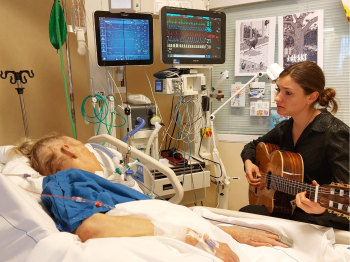Waarmee kunnen we u helpen?
Music therapy is the professional use of music within clinical settings, grounded in scientific research, practical experience, and expert knowledge. It involves collaboration between the patient, therapist, and other healthcare professionals to achieve personalised therapeutic goals through targeted musical interventions. Music therapy can activate motor skills, support speech, language and cognitive functions, and reduce stress and anxiety.
Music Therapy for Motor Function

Movement disorders, such as Parkinson’s disease, Huntington’s disease, stroke, or cerebral palsy, affect the ability to move smoothly and in a coordinated manner. Music can be effective in this context. Thanks to the unique collaboration between auditory and motor regions in the brain, rhythmic music can support and enhance motor processes (Zatorre et al., 2007).
When we listen to music, more occurs than just auditory processing. Rhythmic sounds directly activate motor regions in the brain, such as the supplementary motor area (SMA) and the premotor cortex, through a rapid connection between hearing and movement. As a result, the brain can translate music into motor control, making movement easier (Zatorre et al., 2007).
The basal ganglia also play a crucial role in rhythm processing. These brain structures help recognise regularity and prepare movements in time with the music. Rhythm acts as an external engine that initiates movement (Grahn & Brett, 2009). In addition, the cerebellum fine-tunes timing and coordination. Together, the basal ganglia and the cerebellum form a ‘dual timing system’ in the brain: the basal ganglia maintain tempo (beat-based timing), while the cerebellum is responsible for precise duration and coordination of movements (Kotz et al., 2018).
Research shows that music therapy does more than merely support movement. Music can stimulate neuroplasticity—the brain’s ability to adapt. This means that music, even in the presence of brain damage, can help activate and strengthen alternative pathways for movement (Sihvonen et al., 2017). Consequently, people with movement disorders can not only move more effectively but also experience increased enjoyment, motivation, and relaxation during therapy.
Music Therapy for Speech and Language

Speech and language processing in the brain primarily occurs in the left hemisphere, with key areas such as Broca’s area (for speech production) and Wernicke’s area (for language comprehension). Damage to these areas, for instance due to a stroke, can lead to aphasia, causing difficulties with speaking, understanding, reading, or writing (Fridriksson et al., 2012). Interestingly, music and language share partially overlapping neural networks, such as those involved in rhythm and prosody processing, making music a powerful tool in language rehabilitation (Patel, 2017; Thaut, 2005).
Music therapy leverages this overlap, particularly in treating aphasia. Research on Speech-Music Therapy for Aphasia (SMTA) shows that rhythmic and melodic elements can support speech production by activating alternative, often right-hemispheric, networks (Hurkmans et al., 2012). Patients rhythmically repeat spoken sentences or sing melodies that mimic the natural prosody of speech, helping to regain fluency. This approach aligns with the brain’s neuroplasticity, whereby undamaged areas can take over functions from affected regions (Fridriksson et al., 2012).
The use of music therapy in hospitals thus provides valuable support for speech and language difficulties. By engaging the brain’s shared networks for music and language, music therapy enhances communication skills in neurological conditions and contributes to patients’ quality of life (Thaut et al., 2014).
Music Therapy for Cognitive Function

Cognitive functions such as attention, memory, and executive functions are governed by complex brain networks, including the frontal, temporal, and parietal lobes (Lezak et al., 2012). The frontal lobes are particularly crucial for executive functions such as planning, flexibility, and problem-solving (Stuss & Alexander, 2000; Miyake et al., 2000). Notably, many of these brain regions are also involved in music processing. Music not only activates auditory areas but also engages cognitive networks related to memory, attention, and emotional regulation (Koelsch, 2020; Thaut, 2005). This results in a strong overlap between the neural processes involved in music and cognition.
Music therapy makes use of this overlap to support or restore cognitive functions in hospitalised patients. In neurological conditions such as traumatic brain injury, dementia, or post-stroke states, cognitive rehabilitation can be supported through music. Rhythmic stimulation and structured musical interventions can help improve attention, working memory, and task initiation (Sohlberg & Mateer, 1989; Thaut & Hoemberg, 2014). Melodic (expectation) patterns may also be used in training for neglect (Thaut et al., 2005; 2020).
Within the hospital setting, music therapy can therefore be used to support cognitive rehabilitation. By employing rhythm, melody, and repetition, interventions can be tailored to specific cognitive goals, such as improving attention, memory, neglect, initiative, inhibition training, and more. Thanks to the broad and deep activation of cognitive networks through music, music therapy offers an effective and motivating supplement to traditional cognitive rehabilitation programmes (Thaut, 2003).
Music Therapy in the Intensive Care Unit

Music is processed in the brain via extensive neural networks, including the auditory cortex, prefrontal cortex, limbic system, and subcortical structures. Interestingly, some of these networks may remain relatively intact in patients with disorders of consciousness or in a minimally conscious state. Functional imaging shows that familiar or emotionally charged music can elicit activity in regions associated with memory, emotion, and even consciousness in such cases (O’Kelly et al., 2013; Rolnick & Altenmüller, 2014).
Research demonstrates that music therapy can increase arousal and behavioural responsiveness during and after sessions (O’Kelly et al., 2013), and that it may also enhance functional brain connectivity (Rolnick & Altenmüller, 2014). Emotionally charged music, such as favourite songs, tends to evoke stronger responses than neutral music.
The auditory systems in the brain are often well preserved following severe brain injury, which means that music offers a unique gateway to unconscious or otherwise inaccessible cognitive processes. Music activates, among others, the default mode network and areas involved in self-awareness and autobiographical memory—key components for detecting signs of (recovering) consciousness (Rolnick & Altenmüller, 2014).
Music therapy thus presents unique opportunities for disorders of consciousness. By utilising relatively intact auditory processing and the emotional power of music, it may stimulate and help detect signs of consciousness.
Sources & References
Click here to view the sources and references


